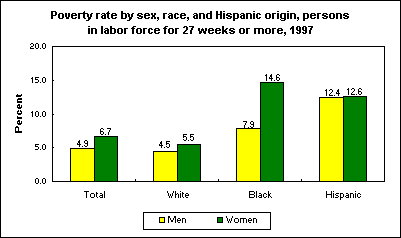An official website of the United States government
 United States Department of Labor
United States Department of Labor
The poverty rate for working women was 6.7 percent in 1997—close to 2 percentage points higher than the rate for working men.

[Chart data—TXT]
Of black working women, 14.6 percent lived below the poverty level in 1997, compared to 7.9 percent of black working men. The difference between the rates for white women and men was much smaller—5.5 percent of white working women were among the working poor, compared to 4.5 percent of white working men.
Among Hispanic workers, the poverty rates were nearly the same for women and men. In 1997, 12.6 percent of Hispanic working women and 12.4 percent of Hispanic working men lived below the poverty level.
Note that poverty status is defined in terms of family unit. The earnings of others in the family and the presence of dependents are important factors in a person’s poverty status.
These data on poverty rates are from the Current Population Survey. The above figures are for individuals who spent at least 27 weeks in the labor force in 1997. Find out more in "A Profile of the Working Poor, 1997," BLS Report 936.
Bureau of Labor Statistics, U.S. Department of Labor, The Economics Daily, Poverty rates higher for working women at https://www.bls.gov/opub/ted/1999/sept/wk2/art04.htm (visited December 30, 2025).

